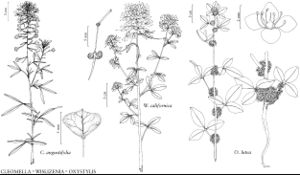Cleomella
in A. Pde Candolle and A. L. P. P. de Candolle, Prodr. 1: 237. 1824.
| Taxon | Illustrator ⠉ | |
|---|---|---|
 | Cleomella angustifolia Wislizenia californica Oxystylis lutea | Yevonn Wilson-Ramsey Yevonn Wilson-Ramsey Yevonn Wilson-Ramsey |
Herbs, usually annual [perennial] (usually unpleasantly scented). Stems sparsely or profusely branched (usually erect); glabrous, pubescent, or scabrous. Leaves: stipules (sometimes deciduous), 3–8-palmatifid, threadlike, or setaceous; petiole without pulvinus (usually longer than leaflets); leaflets (1 or) 3. Inflorescences terminal, racemes, corymbs, or flowers solitary in distal leaf-axils (sometimes remaining compact in fruit); bracts usually present (pedicels often anthocyanic). Flowers actinomorphic; sepals persistent, connate basally (ca. 1/4 of length) [distinct], equal (each often subtending a nectary); petals equal; stamens 6 (usually exserted, distinct, equal); filaments inserted on a discoid or conical androgynophore, glabrous; anthers (ellipsoid), coiling as pollen released; gynophore reflexed, spreading, or ascending in fruit. Fruits capsules, dehiscent (as long as or shorter than wide), rhomboidal, globose, deltoid, or ovoid (valves laterally expanded, falling away from round, persistent septum). Seeds 1–16, globose or reniform, not arillate, (cleft fused between ends). x = 20.
Distribution
United States, Mexico
Discussion
Species 10 (8 in the flora).
The two extraterritorial species of Cleomella are C. mexicana de Candolle and C. perennis H. H. Iltis, both known from central and northern Mexico.
Selected References
Lower Taxa
Key
| 1 | Gynophore 0.5-3 mm in fruit; petals 1.5-2.8 mm | > 2 |
| 1 | Gynophore 2.5-17 mm in fruit; petals 3-9 mm | > 3 |
| 2 | Pedicels recurved in fruit (± equal to gynophore), 1-2 mm; inflorescences solitary flowers in axils of closely spaced leaves. | Cleomella brevipes |
| 2 | Pedicels spreading in fruit (much longer than gynophore), 12-20 mm (in fruit); inflorescences racemes, terminating stems and branches. | Cleomella parviflora |
| 3 | Leaf blade surfaces (and sometimes stems) spreading-hispidulous; styles 2-3(-5) mm; plants usually spreading or matlike, sometimes erect. | Cleomella obtusifolia |
| 3 | Leaf blade surfaces (and stems) glabrous; styles 0.3-2 mm; plants ± erect | > 4 |
| 4 | Gynophore 2.5-6(-8) mm in fruit; bracts ± rudimentary; plants without dominant central stem. | Cleomella palmeriana |
| 4 | Gynophore 3.5-17 mm in fruit; bracts unifoliate or trifoliate (5-25 mm); plants with dominant central stem | > 5 |
| 5 | Leaflet blades ovate-elliptic, oblanceolate, or oblong-lanceolate, 0.4-1.4 cm wide (usually 1.5-2.5 times longer than wide) | > 6 |
| 5 | Leaflet blades linear to elliptic, 0.2-0.8 cm wide (usually 3-10 times longer than wide) | > 7 |
| 6 | Petioles 2-6(-8) cm; petals 1.8-2.2 mm wide; anthers 2.5-3 mm; California, Idaho, Nevada, Oregon, Utah. | Cleomella hillmanii |
| 6 | Petioles 0.8-2 cm; petals 2-4 mm wide; anthers 1.5-1.9 mm; Arizona, New Mexico, Texas. | Cleomella longipes |
| 7 | Sepals deltate, 0.5-1 mm wide; styles 0.3-0.5 mm; gynophore reflexed in fruit; capsules 4-6 × 6-12 mm, rhomboidal; seeds 2-3 mm, rugose. | Cleomella angustifolia |
| 7 | Sepals lanceolate, 0.5-0.7 mm wide; styles 0.8-1.2 mm; gynophore ascending in fruit; capsules 2.5-5 × 2.5-6(-8) mm, ovoid to rhomboidal; seeds 2-2.2 mm, smooth. | Cleomella plocasperma |